Kurnell, New South Wales
| Kurnell Sydney, New South Wales | |||||||||||||||
|---|---|---|---|---|---|---|---|---|---|---|---|---|---|---|---|
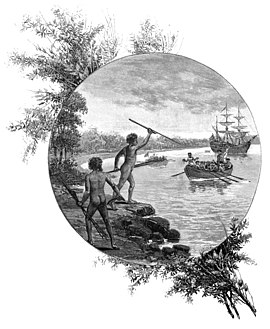 Artwork depicting two Gweagal opposing the landing of James Cook and crew | |||||||||||||||
 | |||||||||||||||
| Population | 2,528 (2021 census)[1] | ||||||||||||||
| Postcode(s) | 2231 | ||||||||||||||
| Elevation | 19 m (62 ft) | ||||||||||||||
| Location | 22 km (14 mi) S of Sydney CBD | ||||||||||||||
| LGA(s) | Sutherland Shire | ||||||||||||||
| State electorate(s) | Cronulla | ||||||||||||||
| Federal division(s) | Cook | ||||||||||||||
| |||||||||||||||
Kurnell is a suburb in Sydney, in the state of New South Wales, Australia. It is 21.4 kilometres (13.3 mi) south of the Sydney central business district, in the local government area of the Sutherland Shire along the east coast. Cronulla and Woolooware are the only adjacent suburbs. La Perouse is located opposite, on the northern headland of Botany Bay. The Cronulla sand dunes are on the south eastern headland of Botany Bay. The eastern side of the peninsula is part of Botany Bay National Park, and Towra Point Nature Reserve is located on the western side of the suburb.
History
[edit]Kurnell is the place where Lieutenant James Cook and his crew landed on 29 April 1770, making first contact with the Gweagal people, the original inhabitants of the area, whilst navigating his way up the East Coast of Australia on Endeavour.[2]
Two Gweagal men challenged the landing and gestured with their spears. Cook's party attempted to communicate their desire for water, but the two men continued to oppose the landing and Cook fired a shot which wounded one of the Aboriginal warriors and forced them to flee.[3]
Cook and his men stayed at Kurnell for a period of eight days. During their time there they collected botanical specimens and mapped the area. When Cook reported back to England he said that the land was suitable for agriculture and was lightly wooded.[4]
Captain Arthur Phillip, arriving in H.M. Armed Tender Supply on 18 January 1788, before the First Fleet arrived, following Cook's advice. They began to clear land and dig wells, near modern-day La Perouse but a week later, Phillip decided to abandon the site and moved north to Sydney Cove at Port Jackson.
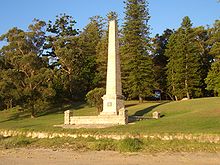
Cook's landing place is located on the north-eastern part of the national park, just near Silver Beach. Sutherland Point is named in honour of a crew member, Scotsman Forby Sutherland, who died of tuberculosis during their eight days here and was buried on the shore. Cape Solander is named after Swedish botanist Daniel Solander, a colleague of Joseph Banks.[a] Inscription Point was named by the Australian Philosophical Society in 1822 when they secured a plaque to the cliff face to mark the point of the Endeavour's crew first landing.
Dampier Street, Tasman Street and Torres Street commemorate other navigators in Australia's history.
The first land grant of 700 acres (283 ha) was made in 1815, to Captain James Birnie, who established Alpha Farm. "Alpha" is the first letter in the Greek alphabet, and the name was thought appropriate for the first farm in the area. In 1821 John Connell Junior was also granted land here and used it for timber getting. His father purchased Alpha Farm from Birnie and by 1842 the Connell family's estate was over one thousand acres (4 km2) in size. In 1860, Alpha Farm was sold to Thomas Holt (1811–88), who owned most of the land that stretched from Sutherland to Cronulla. The area was known as Birniemere for a time and Holtmere was once a locality.
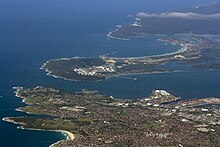

Before the 1920s, Kurnell was used by fishermen as schools of several varieties of fish inhabited the Botany Bay foreshore and the open sea. Fishermen built numerous huts and shacks which sheltered them for the weekend fishing. During the Great Depression, from the late 1920s, many severely affected low-income families took up residence there, in a shantytown.[4]
2015 storm
[edit]On 16 December 2015 a supercell tracked along New South Wales coast producing a strong F2 tornado,[5] high rainfall, hailstones and unusually strong winds. Kurnell was particularly hard hit at about 10:30 am with homes and businesses un-roofed, sewerage and electricity cut, two trucks tipped on their sides, and workers evacuated from Kurnell Refinery and the desalination plant, which was damaged. A "Wind gust of 213 km/h recorded in Kurnell at 10:33am," was "the fastest wind speed recorded in NSW history".[6] Injuries to people were only minor. The damage to Kurnell was calculated to have cost insurers A$206 million.[7] Elsewhere on the same day roof damage occurred at Westfield Bondi Junction and in South Nowra. Thousands of homes lost power in Bulli, Thirroul and Woonona north of Wollongong.[6][8]
Name
[edit]It is possibly a corruption of a Dharug term "cunthal", "kundle" or "koondool", perhaps meaning "place of or where the wild carrot grows".[9] Alternatively it is an Aboriginal corruption of the surname of John Connell, who was granted land in the area in 1821.[10]
Heritage listings
[edit]Kurnell has a number of heritage-listed sites, including:
- Cape Solander Drive: Kamay Botany Bay National Park[11]
Population
[edit]In the 2021 Census, there were 2,528 people in Kurnell. 84.7% of people were born in Australia and 90.3% of people only spoke English at home. The most common responses for religion were No Religion 41.3%, Catholic 24.6% and Anglican 17.8%.[1]
Places of interest
[edit]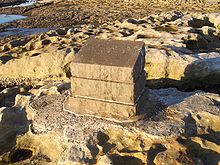
The northern part of the peninsula is a historic site known as Captain Cooks Landing Place with a number of memorials located here:
- Captain Cook Memorial Obelisk
- Kamay Botany Bay Discovery Centre
- Sir Joseph Banks Memorial
- Solander Monument
- Sutherland Monument
- Marton Park (Home of the mighty Kurnell Stingrays) on Game Day
The Discovery Centre provides information and displays relics from the early days in Kurnell's history. Endeavour Heights is a recreation area in the Botany Bay National Park. The Kurnell Lookout provides brilliant views of Botany Bay and the northern headland of Botany Bay at La Perouse. Cape Solander is popular amongst whale watchers during the migration season.
Commercial areas
[edit]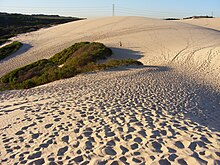
The small residential area with a population of 2,260 is located to the north with a small group of shops in the village of Kurnell. Sand mining on the peninsula has depleted the area of much of the sand that was originally there. It has been said that 40-metre deep pools now form in the dunes[12] and are clearly visible in view from Google Earth. The remaining sand dune is used as a recreational off-road area for 4-wheel drives. The Cronulla sand dunes formed part of the location for the films Forty Thousand Horsemen, directed by Charles Chauvel in 1940 and Mad Max Beyond Thunderdome.
Kurnell is dominated by an industrial area, which once included the Caltex Oil Refinery which is now closed. It now functions as a bulk fuels import terminal to supply imported fuel for Australian customers. Refined petrol is piped to the other side of Botany Bay in an underwater pipeline. The Kurnell Desalination Plant, opened in 2010, now provides much of the rest of Sydney with an alternative water supply.[13] It has been criticised on environmental grounds (greenhouse gases and impact of large amounts of deoxygenated brine), and was shelved, but was resumed after the March 2007 NSW state elections. Continued widespread protest by residential, environmental, and community groups was declared to be irrelevant. Immediate work began on a pipeline under Botany Bay to carry desalinated water to northern suburbs and the size of the desalination plant was doubled. The water supply of Kurnell is supplemented with bore water. Total water stored in the Sydney catchment was at a low of 36.9% on 7 June 2007 but rainfall increased volume stored to 64% as of 7 February 2008,[14] before reaching over 98% capacity in March 2012.[15]
Transport
[edit]U-Go Mobility operates bus route 987 Kurnell to Cronulla via North Cronulla.[16]
Wharves are being built at Kurnell and northward at La Perouse, for a ferry service between them.[17]
Sport and recreation
[edit]Kurnell is home to the Stingrays JRLFC, one of the Shire's rugby league clubs. Green hills Skatepark is located in Kurnell on Captain Cook Drive. It consists of a small and large bowl and street sections. Triathlons are held in Kurnell annually. There are running tracks through Botany Bay National Park, as well as running along the beach and swimming in the netted area of Silver Beach. This location also offers fishing, sailing, scuba diving and windsurfing activities. There is a free shuttle bus service during whale watching season, departing from the parking area of the office of the National Park. Boat Harbour Beach is the location of a 4WD park. Access can be gained via Captain Cook Drive. People are permitted to drive on the beach with their 4WDs. An entry fee is required and one may drive along the beach for at least two kilometres.
Gallery
[edit]-
Kurnell flag masts at sunset
-
Sutherland's monument
-
Kurnell sandstone cliffs, view towards Pacific Ocean
-
Sir Joseph Banks Memorial
-
Cliff and Pacific Ocean view
References
[edit]- ^ a b Australian Bureau of Statistics (28 June 2022). "Kurnell (State Suburb)". 2021 Census QuickStats. Retrieved 14 September 2024.
- ^ KURNELL, kurnell.com About AUSTRALIA. "AUSTRALIA – KURNELL, Birthplace of the Modern Australian Nation, Captain's Cook's Landing Place .au". www.kurnell.com. Retrieved 13 January 2018.
- ^ "Kamay – Botany Bay". National Museum of Australia. Retrieved 26 April 2024.
- ^ a b "Kurnell – A Pictorial History". www.ssec.org.au. Archived from the original on 22 May 2009. Retrieved 13 January 2018.
- ^ "Severe Storms Archive". www.bom.gov.au. Retrieved 4 May 2019.
- ^ a b "Sydney residents in shock after tornado". SBS News. Special Broadcasting Service. 16 December 2015. Retrieved 16 December 2015.
- ^ "Catastrophic summer events cost insurers more than $550m". ABC News. Australian Broadcasting Corporation. 25 March 2016. Retrieved 16 February 2017.
- ^ "Sydney tornado: Clean-up underway in Kurnell after 'unprecedented' storm delivers 213 km/h winds". ABC News. Australian Broadcasting Corporation. 16 December 2015. Retrieved 16 December 2015.
- ^ "THE NAME OF KURNELL". The Sydney Morning Herald. No. 23, 371. New South Wales, Australia. 6 December 1912. p. 7. Retrieved 15 November 2019 – via National Library of Australia.
- ^ "Kurnell". Geographical Names Register (GNR) of NSW. Geographical Names Board of New South Wales. Retrieved 15 November 2019.
- ^ "Kamay Botany Bay National Park (North and South) and Towra Point Nature Reserve". New South Wales State Heritage Register. Department of Planning & Environment. H01918. Retrieved 18 May 2018.
 Text is licensed by State of New South Wales (Department of Planning and Environment) under CC BY 4.0 licence.
Text is licensed by State of New South Wales (Department of Planning and Environment) under CC BY 4.0 licence.
- ^ "The Kurnell Peninsula – Sand Dunes". www.ssec.org.au. Retrieved 13 January 2018.
- ^ "Sydney desalination plant opens". The Sydney Morning Herald. 28 January 2010. Retrieved 13 January 2018.
- ^ Water storage and supply reports – Sydney Catchment Authority
- ^ 8 March 2012 Water storage and supply reports – Sydney Catchment Authority
- ^ "Transdev NSW route 987". Transport for NSW.
- ^ O'Sullivan, Matt (19 May 2024). "Sydney's new $78 million ferry wharves are set to open, without the ferries". Sydney Morning Herald. Retrieved 19 May 2024.






